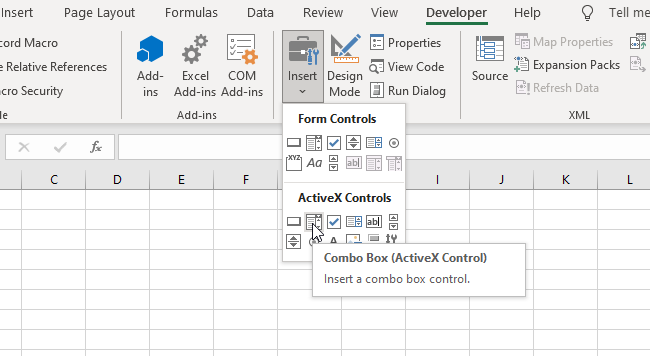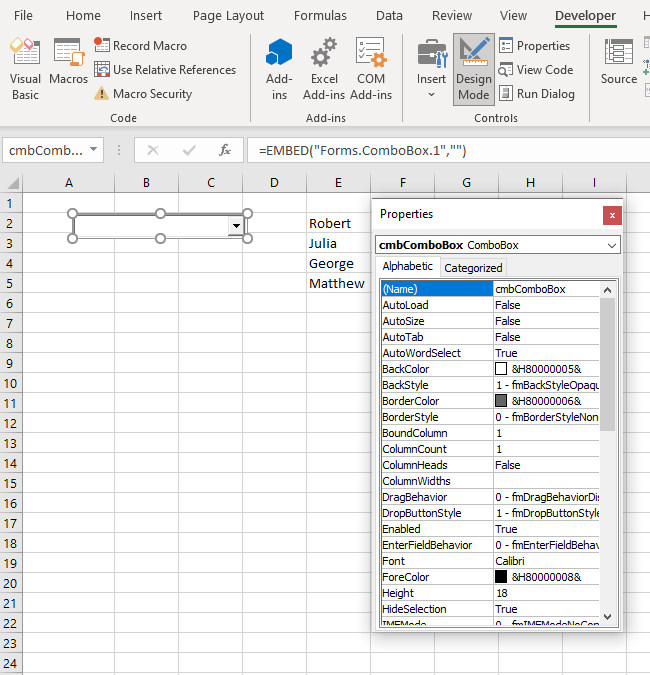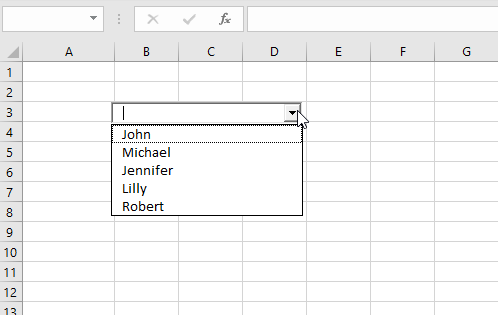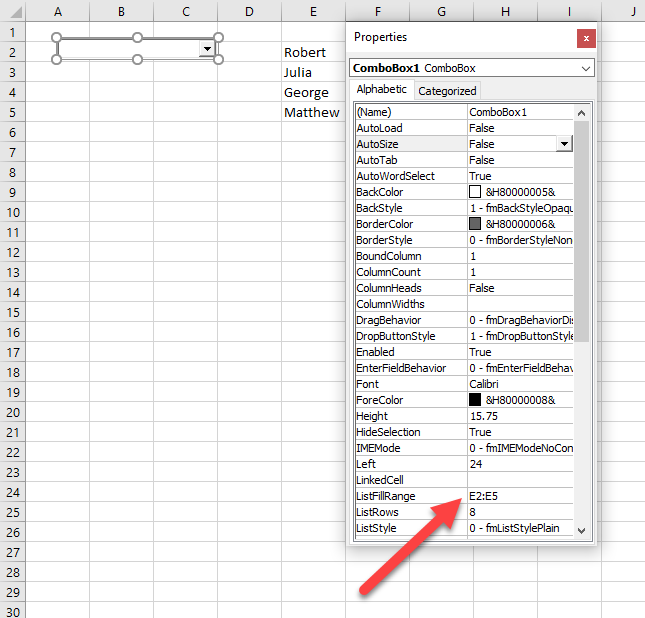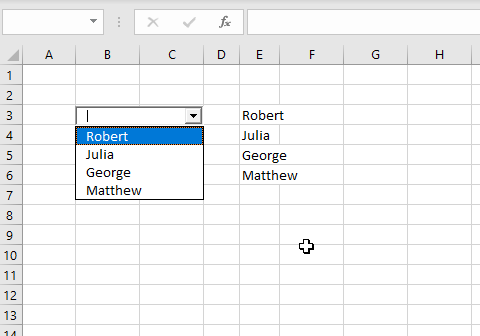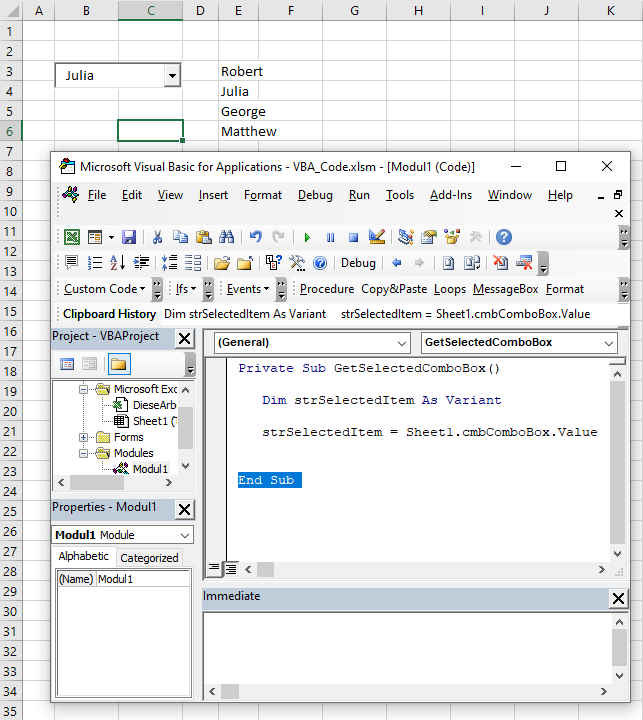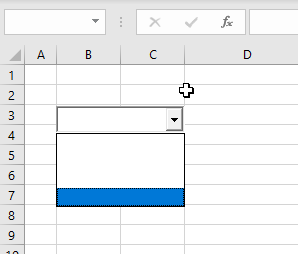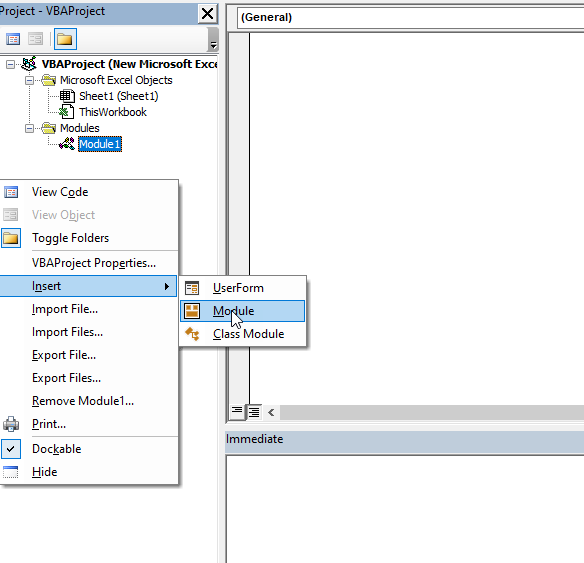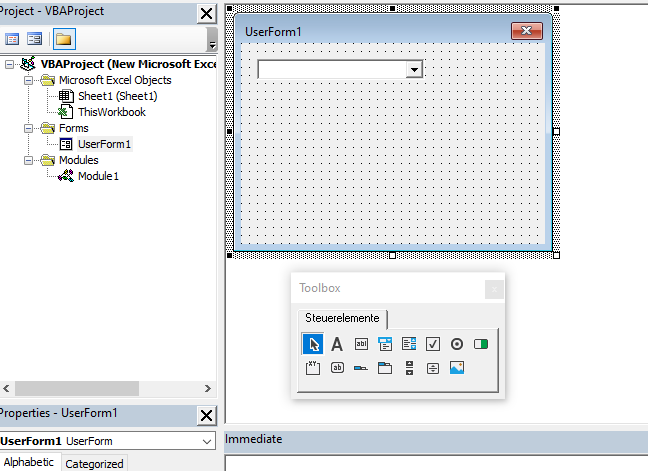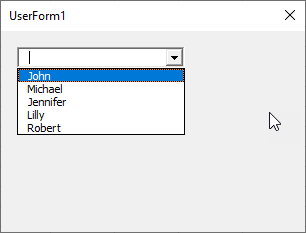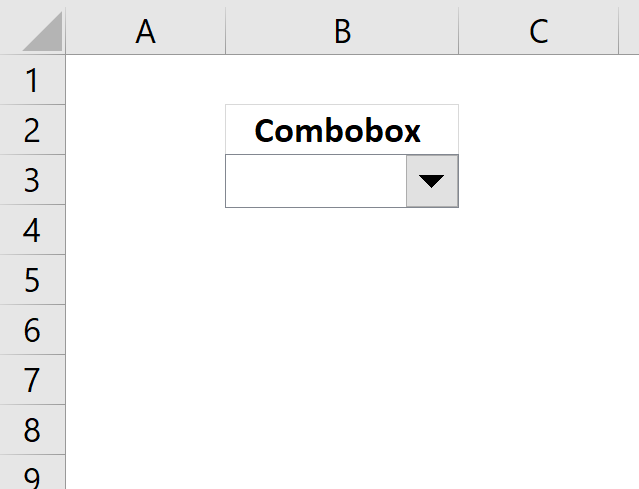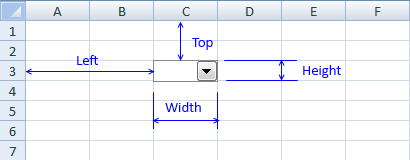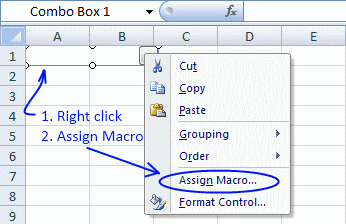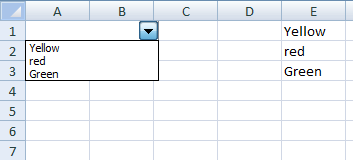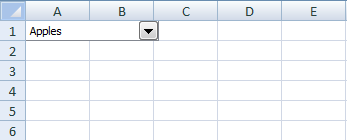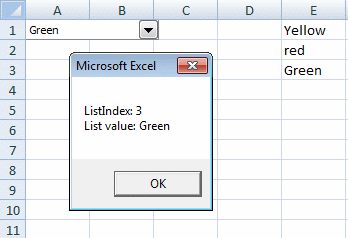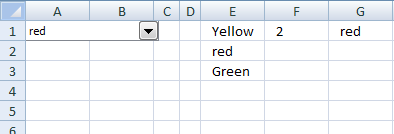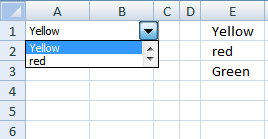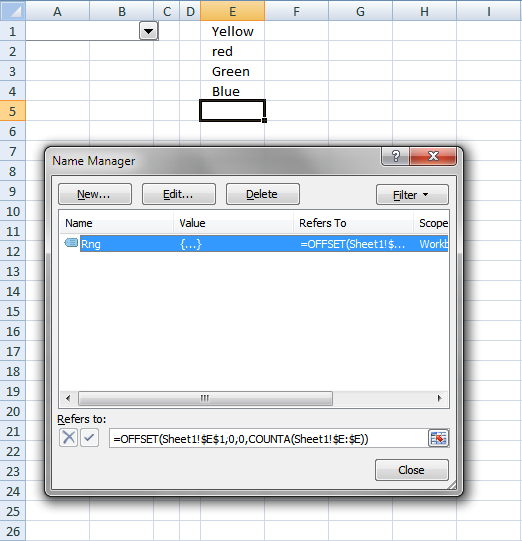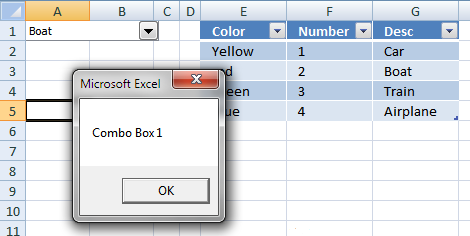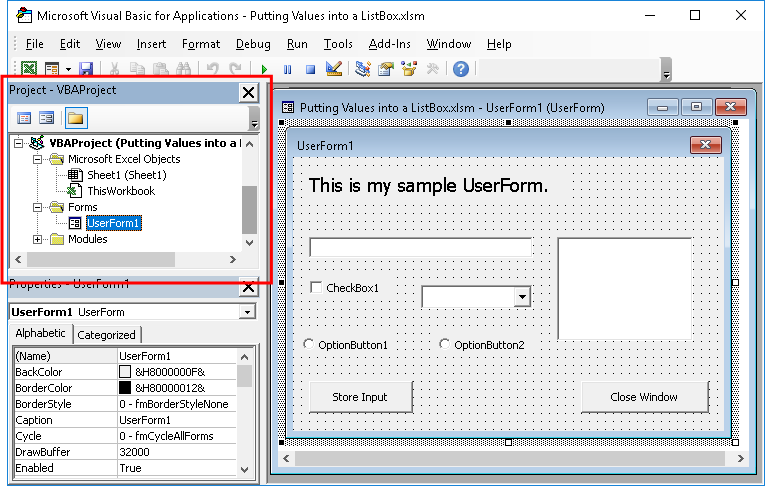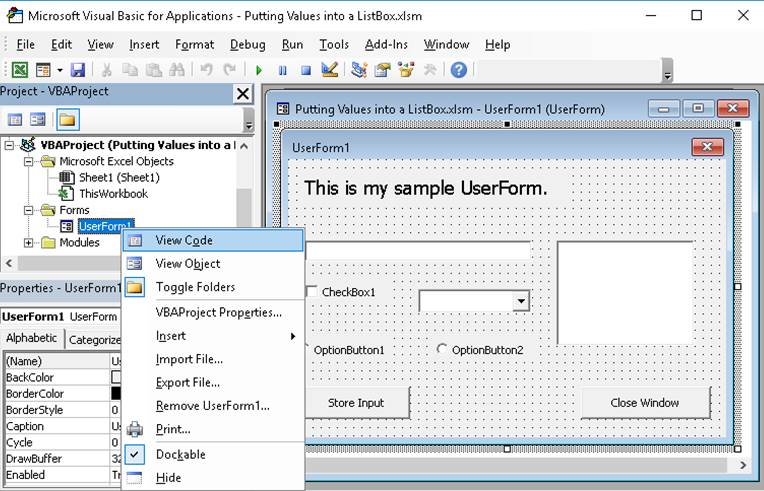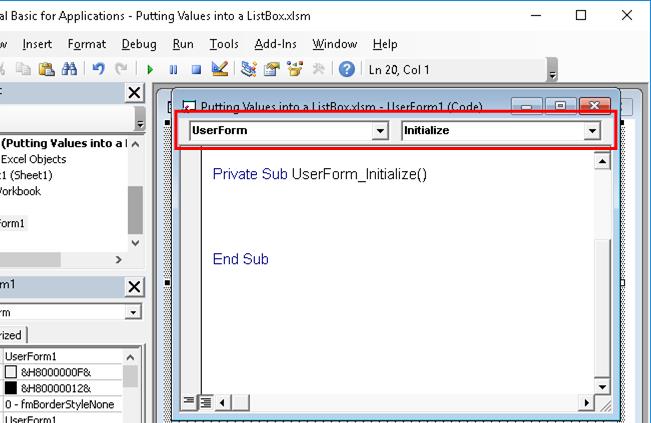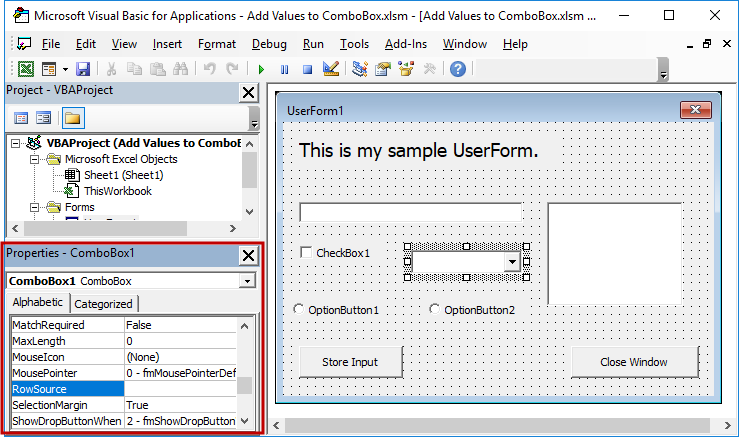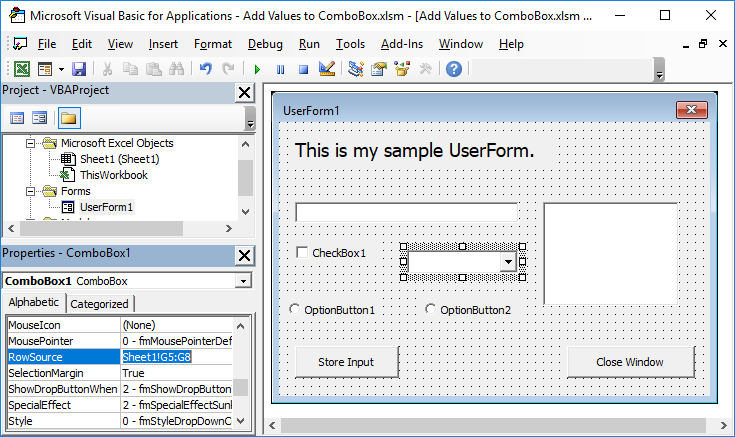Элемент управления пользовательской формы ComboBox для выбора и ввода информации в VBA Excel. Свойства поля с раскрывающимся списком, заполнение, извлечение данных, примеры кода.
UserForm.ComboBox – это элемент управления пользовательской формы, предназначенный для передачи в код VBA информации, выбранной пользователем из раскрывающегося списка или введенной с клавиатуры.
ComboBox представляет из себя комбинацию двух элементов управления: текстового поля (TextBox) и списка (ListBox), поэтому его еще называют «комбинированным списком» или «полем со списком». Также ComboBox сочетает в себе свойства этих двух элементов управления.
Изначально комбинированный список прорисовывается на форме в виде текстового поля с кнопкой для отображения раскрывающегося списка. Далее по тексту будем использовать слово «поле» в значении текстового поля в составе элемента управления ComboBox, а словосочетание «раскрывающийся список» – в значении списка в составе элемента управления ComboBox.
Поле со списком используется в тех случаях, когда необходимо добавить в форму информацию, которая заранее известна, а ее отдельные позиции можно сгруппировать в список, а также для ручного ввода с клавиатуры или вставки из буфера обмена, если необходимое значение в списке отсутствует.
Элемент управления ComboBox незаменим при больших списках. При списках из нескольких позиций его можно заменить на ListBox, который отображает позиции для выбора сразу после загрузки формы, не требуя дополнительных действий от пользователя.
Свойства поля со списком
| Свойство | Описание |
|---|---|
| AutoSize | Автоподбор размера комбинированного поля. True – размер автоматически подстраивается под длину выбранной или введенной строки. False – размер элемента управления определяется свойствами Width и Height. |
| AutoTab | Включение автоматической табуляции – передачи фокуса следующему элементу управления при достижении максимального числа символов при значениях свойства MaxLenght > 0. True – автоматическая табуляция включена, False – выключена. |
| ColumnCount | Указывает количество столбцов в раскрывающемся списке. Значение по умолчанию = 1. |
| ColumnHeads | Добавляет строку заголовков в раскрывающийся список. True – заголовки столбцов включены, False – заголовки столбцов выключены. Значение по умолчанию = False. |
| ColumnWidths | Ширина столбцов в раскрывающемся списке. Значения для нескольких столбцов указываются в одну строку через точку с запятой (;). |
| ControlSource | Ссылка на ячейку для ее привязки к элементу управления ComboBox. |
| ControlTipText | Текст всплывающей подсказки при наведении курсора на элемент управления. |
| Enabled | Доступ пользователя к полю и раскрывающемуся списку. True – доступ разрешен, False – доступ запрещен*. Значение по умолчанию = True. |
| Font | Шрифт, начертание и размер текста в поле. |
| Height | Высота элемента управления ComboBox. |
| Left | Расстояние от левого края внутренней границы пользовательской формы до левого края комбинированного списка. |
| List | Позволяет заполнить ComboBox данными из одномерного или двухмерного массива, а также обращаться к отдельным элементам раскрывающегося списка по индексам для записи и чтения. |
| ListIndex | Номер выбранной пользователем строки в раскрывающемся списке. Нумерация начинается с нуля. Если ничего не выбрано, ListIndex = -1. |
| ListRows | Количество видимых строк в раскрытом списке. Если общее количество строк больше ListRows, появляется полоса прокрутки. Значение по умолчанию = 8. |
| Locked | Запрет на отображение раскрывающегося списка, ввод и редактирование данных в поле. True – ввод и редактирование запрещены**, False – ввод и редактирование разрешены. Значение по умолчанию = False. |
| MatchRequired | Задает проверку вводимых в поле строк с элементами списка. True – проверка включена (допускается ввод только строк, совпадающих с элементами списка), False – проверка выключена (допускается ввод любых строк). Значение по умолчанию = False. |
| MaxLenght | Максимальная длина строки в поле. Значение по умолчанию = 0, что означает – ограничений нет. |
| RowSource | Источник строк для раскрывающегося списка (адрес диапазона на рабочем листе Excel). |
| TabIndex | Целое число, определяющее позицию элемента управления в очереди на получение фокуса при табуляции. Отсчет начинается с 0. |
| Text | Текстовое содержимое (значение) поля (=Value). |
| TextAlign | Выравнивание текста в поле: 1 (fmTextAlignLeft) – по левому краю, 2 (fmTextAlignCenter) – по центру, 3 (fmTextAlignRight) – по правому краю. |
| Top | Расстояние от верхнего края внутренней границы пользовательской формы до верхнего края комбинированного списка. |
| Value | Текстовое содержимое (значение) поля (=Text). |
| Visible | Видимость поля со списком. True – ComboBox отображается на пользовательской форме, False – ComboBox скрыт. |
| Width | Ширина элемента управления. |
* При Enabled в значении False пользователь не может раскрывать список, а также вводить или редактировать данные в поле.
** Для элемента управления ComboBox действие свойства Locked в значении True аналогично действию свойства Enabled в значении False.
В таблице перечислены только основные, часто используемые свойства поля со списком. Еще больше доступных свойств отображено в окне Properties элемента управления ComboBox, а все методы, события и свойства – в окне Object Browser.
Вызывается Object Browser нажатием клавиши «F2». Слева выберите объект ComboBox, а справа смотрите его методы, события и свойства.
Свойства BackColor, BackStyle, BorderColor, BorderStyle отвечают за внешнее оформление комбинированного списка и его границ. Попробуйте выбирать доступные значения этих свойств в окне Properties, наблюдая за изменениями внешнего вида элемента управления ComboBox на проекте пользовательской формы.
Способы заполнения ComboBox
Используйте метод AddItem для загрузки элементов в поле со списком по одному:
|
With UserForm1.ComboBox1 .AddItem «Элемент 1» .AddItem «Элемент 2» .AddItem «Элемент 3» End With |
Используйте свойство List, чтобы скопировать одномерный массив значений в элемент управления ComboBox:
|
UserForm1.ComboBox1.List = Array(«Строка 1», _ «Строка 2», «Строка 3», «Строка 4», «Строка 5») |
Вместо функции Array можно использовать переменные одномерных и двухмерных массивов. При загрузке значений из двухмерного массива, требуется предварительно указать количество столбцов в комбинированном списке.
Используйте свойство RowSource, чтобы загрузить в ComboBox значения из диапазона ячеек рабочего листа:
|
UserForm1.ComboBox1.RowSource = «Лист5!B1:B15» |
При загрузке данных из диапазона, содержащего более одного столбца, требуется предварительно указать количество столбцов в комбинированном списке:
|
With UserForm1.ComboBox1 ‘Указываем количество столбцов .ColumnCount = 5 .RowSource = «‘Таблица с данными’!A1:E20» End With |
В качестве имени листа используется имя ярлыка. Если имя листа содержит пробелы, оно заключается в одинарные кавычки.
Подробнее о заполнении элемента управления ComboBox вы можете ознакомиться в отдельной статье с наглядными примерами. И еще более подробно – в статье о заполнении ListBox, так как ListBox заполняется теми же способами, что и ComboBox.
Привязка поля со списком к ячейке
Чтобы привязать комбинированный список к ячейке на рабочем листе Excel, необходимо свойству ControlSource присвоить адрес ячейки. Это можно сделать непосредственно в окне Properties элемента управления ComboBox или в коде VBA:
UserForm1.ComboBox1.ControlSource = "Лист1!B2"
Имя листа для составного адреса ячейки берется из названия ярлыка. Если имя листа содержит пробелы, оно заключается в одинарные кавычки. При указании адреса без имени листа, ComboBox привязывается к ячейке на активном листе.
В результате привязки образуется взаимосвязь между свойством Value комбинированного списка и значением ячейки. Все изменения в поле ComboBox дублируются в привязанной ячейке и наоборот, изменения в ячейке приводят к изменению текста в поле.
Чтобы протестировать результаты привязки ячейки к полю со списком ComboBox1, разместите на пользовательской форме UserForm1 еще какой-нибудь элемент управления и запустите следующий код VBA Excel:
|
Sub Test() With UserForm1.ComboBox1 ‘Заполняем список ComboBox1 данными .List = Array(«Красный», «Оранжевый», «Желтый», _ «Зеленый», «Голубой», «Синий», «Фиолетовый») ‘Привязываем ComboBox1 к ячейке «A1» .ControlSource = «A1» ‘Открываем форму в немодальном окне End With UserForm1.Show 0 End Sub |
В результате работы кода пользовательская форма откроется в немодальном окне со значением в поле, скопированном из ячейки «A1» активного листа. Немодальное окно формы позволит редактировать ячейку «A1», не закрывая форму.
Меняйте значение ячейки «A1», нажимайте клавишу «Tab» или «Enter», поле комбинированного списка примет значение ячейки. Меняйте значение поля ComboBox1 с помощью клавиатуры или выбирайте из раскрывающегося списка, нажимайте клавишу «Tab» или «Enter», ячейка «A1» примет значение поля со списком.
Дополнительный элемент управления на форме нужен для передачи ему фокуса нажатием клавиши «Tab» или «Enter», чтобы завершить ввод значения в поле ComboBox1. Иначе новое значение поля будет передано в ячейку «A1» только при закрытии формы.
Значение ComboBox по умолчанию
В раскрывающийся список элемента управления ComboBox1 загружены названия семи основных цветов:
|
Private Sub UserForm_Initialize() With Me.ComboBox1 .List = Array(«Красный», «Оранжевый», «Желтый», _ «Зеленый», «Голубой», «Синий», «Фиолетовый») ‘Сюда добавляем код вставки значения по умолчанию End With End Sub |
Есть несколько вариантов сделать так, чтобы при открытии пользовательской формы в поле ComboBox1 было отображено значение по умолчанию. Код следует вставлять перед строкой «End With».
|
‘Вариант 1 (произвольная строка) .Value = «Моя строка по умолчанию» ‘или .Value = «Синий» ‘Вариант 2 (произвольная строка) .ControlSource = «A1» Range(«A1») = «Моя строка по умолчанию» ‘или .ControlSource = «A1» Range(«A1») = «Желтый» ‘Вариант 3 (строка из списка) .ListIndex = 0 ‘Красный ‘или .ListIndex = 3 ‘Зеленый |
Кроме значения по умолчанию, в свойства комбинированного списка можно добавить текст всплывающей подсказки, который будет отображаться при наведении на ComboBox курсора:
UserForm1.ComboBox1.ControlTipText = "Выберите значение из списка"
Извлечение информации из ComboBox
Первоначально элемент управления ComboBox открывается с пустым полем или значением по умолчанию. Свойства Value и Text в этом случае возвращают пустую строку или текст по умолчанию.
Если пользователь выбрал новое значение из раскрывающегося списка или ввел его с клавиатуры, оно перезапишет значения свойств Value и Text. Из этих свойств мы с помощью кода VBA Excel извлекаем информацию, выбранную или введенную пользователем:
|
Dim myTxt As String myTxt = UserForm1.ComboBox1.Value ‘или myTxt = UserForm1.ComboBox1.Text |
Вторую строку кода можно записать myTxt = UserForm1.ComboBox1, так как Value является свойством поля со списком по умолчанию.
Если вас интересует, как извлечь значение из многостолбцового раскрывающегося списка, смотрите об этом в статье с описанием элемента управления ListBox. Извлечение данных из комбинированного поля аналогично извлечению данных из ListBox. Знакомясь со статьей, следует учесть, что у ComboBox отсутствует многострочный выбор.
Иногда перед загрузкой в ComboBox требуется отобрать уникальные элементы из имеющегося списка. Смотрите, как это сделать с помощью объектов Collection и Dictionary.
In this Article
- Create a ComboBox in Excel Worksheet
- Populate a ComboBox in VBA code
- Populate a ComboBox from a Cells Range
- Get a Selected Item of a ComboBox in VBA
- Clear a ComboBox
- Use a ComboBox in a Userform
This tutorial will demonstrate how to work with ComboBoxes in VBA.
ComboBoxes allow users to select an option from a drop-down menu list. ComboBoxes can be created in VBA UserForms or with an Excel worksheet. In this tutorial, you will learn how to create and manipulate ComboBoxes in VBA and in Excel worksheets.
If you want to learn how to create a Listbox, click here: VBA Listbox
If you want to learn how to create a Checkbox, click here: VBA Checkbox
Create a ComboBox in Excel Worksheet
In order to insert a ComboBox in the Worksheet, you need to go to the Developer tab, click Insert and under ActiveX Controls choose Combo Box:
Image 1. Insert a ComboBox in the Worksheet
When you select the ComboBox which you inserted, you can click on Properties under the Developer tab:
Image 2. Change ComboBox Properties
Here you can set different properties of the ComboBox. To start, we changed the attribute Name to cmbComboBox. Now, we can use the ComboBox with this name in VBA code.
Populate a ComboBox in VBA code
First, we need to populate the ComboBox with values. In most cases, a ComboBox needs to be populated when the Workbook is opened. Because of this, we need to put a code for populating the ComboBox in object Workbook, procedure Open. This procedure is executed every time a user opens the Workbook. Here is the code:
With Sheet1.cmbComboBox
.AddItem "John"
.AddItem "Michael"
.AddItem "Jennifer"
.AddItem "Lilly"
.AddItem "Robert"
End WithWhen you click on the drop-down menu, you will get 5 names to choose from (John, Michael, Jennifer, Lilly and Robert):
Image 3. Populate the ComboBox in VBA
Populate a ComboBox from a Cells Range
Another possible way to populate a ComboBox is to let a user do it. A ComboBox can be linked to the cells range. In this approach, every time a user enters a new value in the cells range, the ComboBox will update with that value.
If you want to enable this, you have to go to the Properties of the ComboBox and set the attribute ListFillRange to the cells range (in our case E2:E5):
Image 4. Populate the ComboBox from the cells range
We linked our ComboBox with the range E2:E5, where we put names we want (Nathan, Harry, George, Roberta). As a result, the ComboBox is now populated with these names:
Image 5. Populated ComboBox from the cells range
Get a Selected Item of a ComboBox in VBA
The purpose of a ComboBox is to get a users choice. In order to retrieve a users choice, you need to use this code:
Dim strSelectedItem As Variant
strSelectedItem = Sheet1.cmbComboBox.ValueThe users selection is in the attribute Value of Sheet1.cmbComboBox object. This value is assigned to the variable strSelectedItem:
Image 6. Get a selected value from the ComboBox in VBA
We selected Julia in the ComboBox and executed the procedure. As you can see in Image 5, the value of the strSelectedItem is Julia, which is the value we selected. Now you can process this variable further in the code.
Clear a ComboBox
If you want to clear a ComboBox in VBA, you need to use Clear method of Sheet1.lstComboBox object. It will delete all the items from the ComboBox. Here is the code:
Sheet1.cmbComboBox.ClearNotice that the Clear method does not delete the attribute ListFillRange, so it must be removed from the properties of the ComboBox beforehand.
When we execute the code, we get the empty ComboBox:
Image 7. Clear the ComboBox
Use a ComboBox in a Userform
As we mentioned, Combobox is most often used in Userforms. To explain how you can do it, we will first insert an Userform. In VBA editor, right-click on Module name, click on Insert and choose UserForm:
Image 8. Insert a Userform
To display controls for inserting, you need to enable the Toolbox. To do this, click on the Toolbox icon in the toolbar. After that, you will get the windows with all the controls available. You can click on ComboBox to create it in the Userform.
Image 9. Insert a ComboBox in the Userform
We will name the ComboBox cmbComboBox. In order to populate it with values, we need to put the following code into the method Initialize of the object UserForm:
Private Sub UserForm_Initialize()
With UserForm1.cmbComboBox
.AddItem "John"
.AddItem "Michael"
.AddItem "Jennifer"
.AddItem "Lilly"
.AddItem "Robert"
End With
End SubThis code triggers every time a user runs the Userform and populates the Combobox with these 5 names:
Image 10. The ComboBox with values in the Userform
If you want to get selected value from the ComboBox, you need to use the same logic for the Combobox in a Worksheet, which is explained earlier in the article.
VBA Coding Made Easy
Stop searching for VBA code online. Learn more about AutoMacro — A VBA Code Builder that allows beginners to code procedures from scratch with minimal coding knowledge and with many time-saving features for all users!
Learn More!
You’re VBA Combo Box Cheat Sheet
In this post I am going to share everything I know about using VBA with an Excel Form Control Combo Box (aka drop down). Most of the code is very self-explanatory so I will not write much of a description. However, some of the syntax can be a little tricky so pay close attention to how the code is structured. Please feel free to post comments if I missed an area or you have any questions! Enjoy 
Creating & Sizing/Positioning A Combo Box
Sub ComboBox_Create()
‘PURPOSE: Create a form control combo box and position/size it
Dim Cell As Range
Dim sht As Worksheet
Set sht = ThisWorkbook.Worksheets(«Sheet1»)
‘Create
sht.DropDowns.Add(0, 0, 100, 15).Name = «Combo Box 1»
‘Create & Dimension to a Specific Cell
Set Cell = Range(«B5»)
With Cell
sht.DropDowns.Add(.Left, .Top, .Width, .Height).Name = «Combo Box 2»
End With
‘Create & Dimension to a Specific Cell Range
Set Cell = Range(«B8:D8»)
With Cell
sht.DropDowns.Add(.Left, .Top, .Width, .Height).Name = «Combo Box 3»
End With
End Sub
Deleting A Combo Box
Sub ComboBox_Delete()
‘PURPOSE: Delete a form control combo box
Dim sht As Worksheet
Set sht = ThisWorkbook.Worksheets(«Sheet1»)
sht.Shapes(«Combo Box 1»).Delete
End Sub
Adding Values To A Combo Box
Sub ComboBox_InputRange()
‘PURPOSE: Add values to your drop down list
Dim Cell As Range
Dim sht As Worksheet
Dim myArray As Variant
Dim myDropDown As Shape
Set sht = ThisWorkbook.Worksheets(«Sheet1»)
Set myDropDown = sht.Shapes(«Combo Box 1»)
myArray = Array(«Q1», «Q2», «Q3», «Q4»)
‘Based on data in a range (not linked)
MyDropDown.ControlFormat.List = sht.Range(«A1:A4»).Value
‘Linked to data in a range (automatically changes based on current cell values)
myDropDown.ControlFormat.ListFillRange = «A1:A4»
‘Based on Array values (written out)
MyDropDown.ControlFormat.List = _
Array(«Q1», «Q2», «Q3», «Q4»)
‘Based on Array values (variable)
myDropDown.OLEFormat.Object.List = myArray
‘Add one by one
With myDropDown.ControlFormat
.AddItem «Q1»
.AddItem «Q2»
.AddItem «Q3»
.AddItem «Q4»
End With
End Sub
Overriding Values In The Drop Down List
Sub ComboBox_ReplaceValue()
‘PURPOSE: Replace value of the third item in the drop down list
Worksheets(«Sheet1»).Shapes(«Combo Box 1»).ControlFormat.List(3) = «FY»
End Sub
Removing Values From The Drop Down List
Sub ComboBox_RemoveValues()
‘PURPOSE: Remove a value(s) from the drop down list
Dim Cell As Range
Dim sht As Worksheet
Set sht = ThisWorkbook.Worksheets(«Sheet1»)
‘Remove A Single Item
sht.Shapes(«Combo Box 1»).ControlFormat.RemoveItem 2
‘Remove All Items
sht.Shapes(«Combo Box 1»).ControlFormat.RemoveAllItems
End Sub
Determine Current Selected Value From The Drop Down List
Sub ComboBox_GetSelection()
‘PURPOSE: Determine current selected value in ComboBox
Dim sht As Worksheet
Dim myDropDown As Shape
Set sht = ThisWorkbook.Worksheets(«Sheet1»)
Set myDropDown = sht.Shapes(«Combo Box 1»)
With myDropDown.ControlFormat
MsgBox «Item Number: » & .Value & vbNewLine & «Item Name: » & .List(.Value)
End With
End Sub
Select A Value From The Drop Down List
Sub ComboBox_SelectValue()
‘PURPOSE: Automatically select a value from the drop down list
Dim Cell As Range
Dim sht As Worksheet
Dim Found As Boolean
Dim SetTo As String
Dim x As Long
Set sht = ThisWorkbook.Worksheets(«Sheet1»)
‘Select First List Item
sht.Shapes(«Combo Box 1»).ControlFormat.ListIndex = 3
‘Select Item based on list Name/Value
SetTo = «Q2»
With sht.Shapes(«Combo Box 1»).ControlFormat
For x = 1 To .ListCount
If .List(x) = SetTo Then
Found = True
Exit For
Next x
If Found = True Then .ListIndex = x
End With
End Sub
Link User’s Selection To A Cell (Outputs Numerical List Position)
Sub ComboBox_CellLink()
‘PURPOSE: Output the selection’s list position to a specific cell
Dim sht As Worksheet
Set sht = ThisWorkbook.Worksheets(«Sheet1»)
sht.Shapes(«Combo Box 1»).ControlFormat.LinkedCell = «$A$1»
End Sub
Adjust Drop Down Lines For A Combo Box
Sub ComboBox_DropDownLines()
‘PURPOSE: Set how many drop down lines are visible per scroll
Dim sht As Worksheet
Set sht = ThisWorkbook.Worksheets(«Sheet1»)
sht.Shapes(«Combo Box 1»).ControlFormat.DropDownLines = 12
End Sub
Toggle On/Off 3D Shading
Sub ComboBox_3DShading()
‘PURPOSE: Turn 3D shading on or off
Dim sht As Worksheet
Set sht = ThisWorkbook.Worksheets(«Sheet1»)
‘Turn 3D Shading On
sht.Shapes(«Combo Box 1»).OLEFormat.Object.Display3DShading = True
‘Turn 3D Shading Off
sht.Shapes(«Combo Box 1»).OLEFormat.Object.Display3DShading = False
End Sub
Assigning A Macro To A Combo Box
Sub ComboBox_AssignMacro()
‘PURPOSE: Assign a macro to be triggered when drop down is changed
Dim sht As Worksheet
Set sht = ThisWorkbook.Worksheets(«Sheet1»)
sht.Shapes(«Combo Box 1»).OnAction = «Macro1»
End Sub
Any Others?
If I’ve missed any VBA functionalities please leave a comment in the comments section below so I can continue to grow this list of combo box code! I look forward to hearing your thoughts.
About The Author
Hey there! I’m Chris and I run TheSpreadsheetGuru website in my spare time. By day, I’m actually a finance professional who relies on Microsoft Excel quite heavily in the corporate world. I love taking the things I learn in the “real world” and sharing them with everyone here on this site so that you too can become a spreadsheet guru at your company.
Through my years in the corporate world, I’ve been able to pick up on opportunities to make working with Excel better and have built a variety of Excel add-ins, from inserting tickmark symbols to automating copy/pasting from Excel to PowerPoint. If you’d like to keep up to date with the latest Excel news and directly get emailed the most meaningful Excel tips I’ve learned over the years, you can sign up for my free newsletters. I hope I was able to provide you with some value today and I hope to see you back here soon!
— Chris
Founder, TheSpreadsheetGuru.com
This blog post demonstrates how to create, populate and change comboboxes (form control) programmatically.
Form controls are not as flexible as ActiveX controls but are compatible with earlier versions of Excel. You can find the controls on the developer tab.
Table of Contents
- Create a combobox using vba
- Assign a macro — Change event
- Add values to a combobox
- Remove values from a combo box
- Set the default value in a combo box
- Read selected value
- Link selected value
- Change combobox properties
- Populate combox with values from a dynamic named range
- Populate combox with values from a table
- Currently selected combobox
Watch this video about Combo Boxes
Create a combobox using vba
Sub CreateFormControl()
'Worksheets("Sheet1").DropDowns.Add(Left, Top, Width, Height)
Worksheets("Sheet1").DropDowns.Add(0, 0, 100, 15).Name = "Combo Box 1"
End Sub
Recommended article
Recommended articles
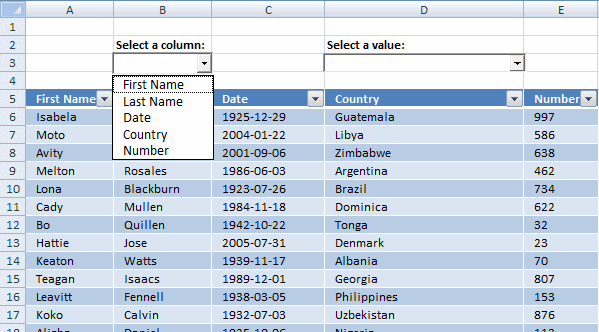
Back to top
Assign a macro — Change event
You can assign a macro to a combobox by press with right mouse button oning on the combobox and select «Assign Macro». Select a macro in the list and press ok!
This subroutine does the same thing, it assigns a macro named «Macro1» to «Combo box 1» on sheet 1. Macro1 is rund as soon as the selected value in the combo box is changed.
Sub AssignMacro()
Worksheets("Sheet1").Shapes("Combo Box 1").OnAction = "Macro1"
End Sub
Recommended article
Recommended articles
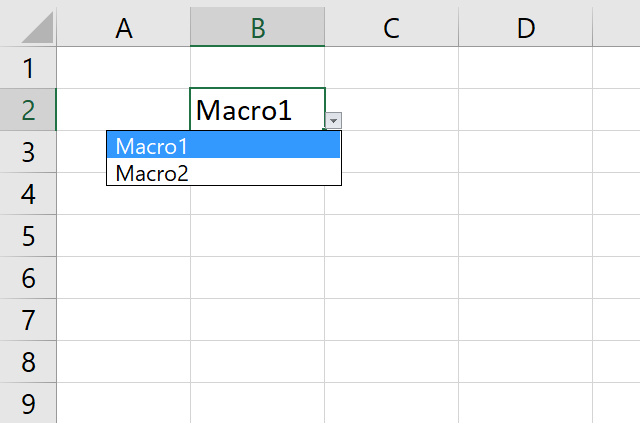
Back to top
Add values to a combo box
You can add an array of values to a combo box. The list method sets the text entries in a combo box, as an array of strings.
Sub PopulateCombobox1()
Worksheets("Sheet1").Shapes("Combo Box 1").ControlFormat.List = _
Worksheets("Sheet1").Range("E1:E3").Value
End Sub
The difference with the ListFillRange property is that the combo box is automatically updated as soon as a value changes in the assigned range. You don´t need to use events or named ranges to automatically refresh the combo box, except if the cell range also changes in size.
Sub PopulateCombobox2()
Worksheets("Sheet1").Shapes("Combo Box 1").ControlFormat.ListFillRange = _
"A1:A3"
End Sub
You can also add values one by one.
Sub PopulateCombobox3()
With Worksheets("Sheet1").Shapes("Combo Box 1").ControlFormat
.AddItem "Sun"
.AddItem "Moon"
.AddItem "Stars"
End Sub
Back to top
Recommended article
Recommended articles
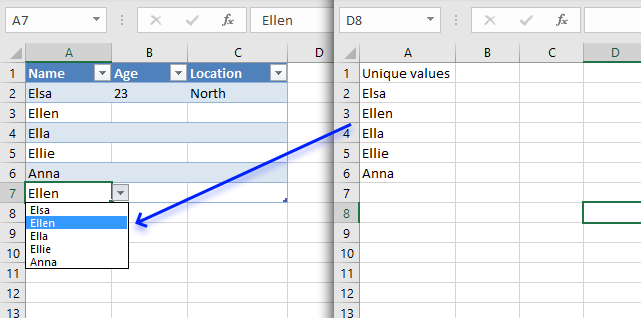
Remove values from a combo box
RemoveAllItems is self-explanatory.
Sub RemoveAllItems()
Worksheets("Sheet1").Shapes("Combo Box 1").ControlFormat.RemoveAllItems
End Sub
The RemoveItem method removes a value using a index number.
Sub RemoveItem()
Worksheets("Sheet1").Shapes("Combo Box 1").ControlFormat.RemoveItem 1
End Sub
The first value in the array is removed.
Recommended article
Recommended articles
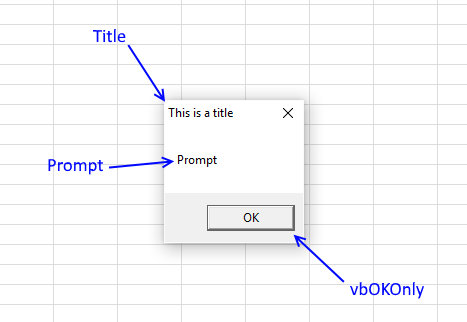
How to use DIALOG BOXES
A dialog box is an excellent alternative to a userform, they are built-in to VBA and can save you time […]
Back to top
Set the default value in a combo box
The ListIndex property sets the currently selected item using an index number. ListIndex = 1 sets the first value in the array.
Sub ChangeSelectedValue()
With Worksheets("Sheet1").Shapes("Combo Box 1")
.List = Array("Apples", "Androids", "Windows")
.ListIndex = 1
End With
End Sub
Recommended article
Recommended articles
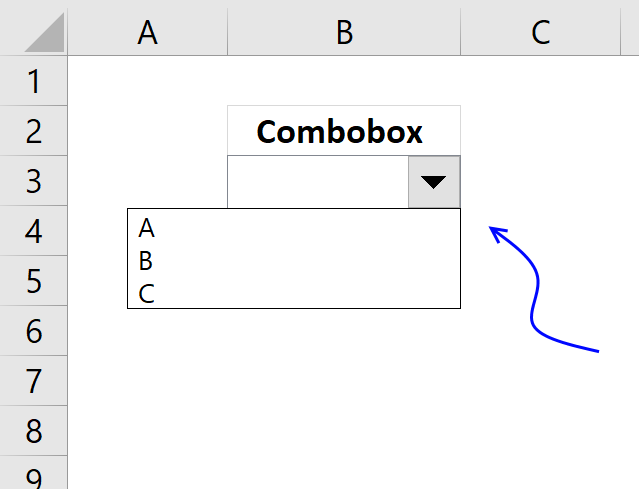
Back to top
Read selected value
The ListIndex property can also return the index number of the currently selected item. The list method can also return a value from an array of values, in a combo box. List and Listindex combined returns the selected value.
Sub SelectedValue()
With Worksheets("Sheet1").Shapes("Combo Box 1").ControlFormat
MsgBox "ListIndex: " & .ListIndex & vbnewline & "List value:" .List(.ListIndex)
End With
End Sub
Recommended article
Recommended articles
Back to top
Link selected value
Cell F1 returns the index number of the selected value in combo box 1.
Sub LinkCell()
Worksheets("Sheet1").Shapes("Combo Box 1").ControlFormat.LinkedCell = "F1"
End Sub
Cell G1 returns the selected value in combo box 1.
Sub LinkCell2()
With Worksheets("Sheet1").Shapes("Combo Box 1").ControlFormat
Worksheets("Sheet1").Range("G1").Value = .List(.ListIndex)
End With
End Sub
Recommended article
Recommended articles
Back to top
Change combobox properties
Change the number of combo box drop down lines.
Sub ChangeProperties()
Worksheets("Sheet1").Shapes("Combo Box 1").ControlFormat.DropDownLines = 2
End Sub
Back to top
Populate combox with values from a dynamic named range
I created a dynamic named range Rng, the above picture shows how.
Sub PopulateFromDynamicNamedRange()
Worksheets("Sheet1").Shapes("Combo Box 1").ControlFormat.ListFillRange = "Rng"
End Sub
You can do the same thing as the subroutine accomplishes by press with right mouse button oning the combo box and then press with left mouse button on «Format Control…». Input Range: Rng
Back to top
Populate combox with values from a table
Sub PopulateFromTable()
Worksheets("Sheet1").Shapes("Combo Box 1").ControlFormat.List = _
[Table1[DESC]]
End Sub
Back to top
Currently selected combobox
It is quite useful to know which combo box the user is currently working with. The subroutine below is assigned to Combo Box 1 and is rund when a value is selected. Application.Caller returns the name of the current combo box.
Sub CurrentCombo() MsgBox Application.Caller End Sub
Back to top
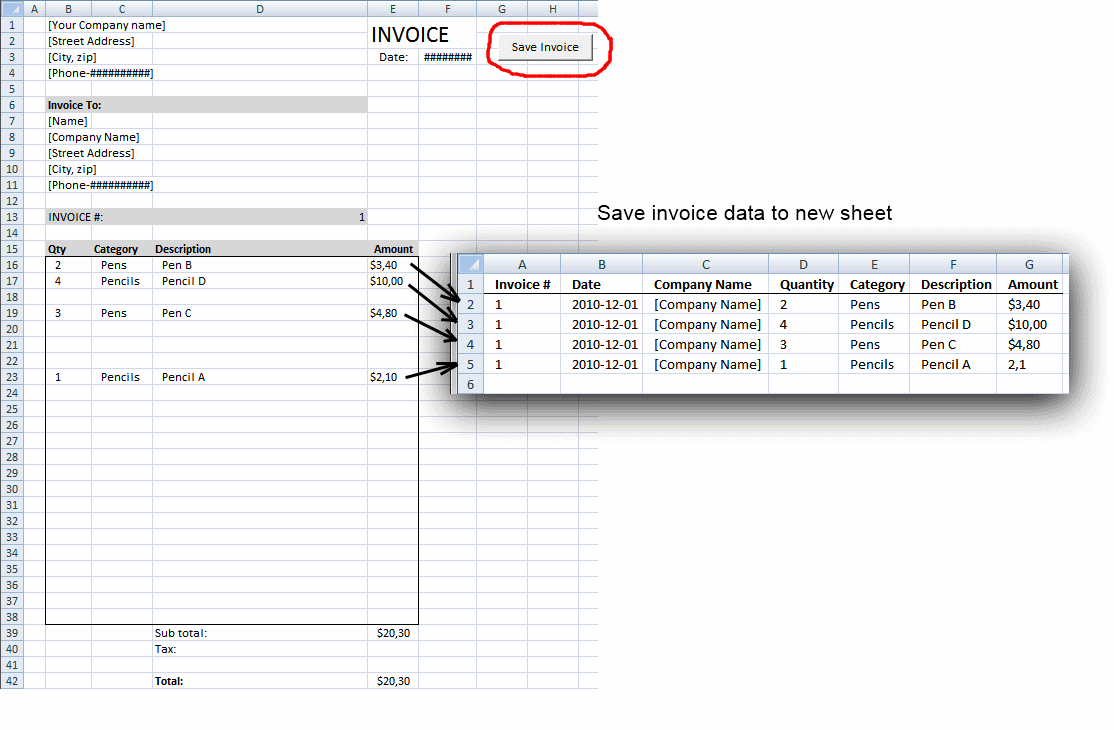
Save invoice data [VBA]
This article demonstrates a macro that copies values between sheets. I am using the invoice template workbook. This macro copies […]
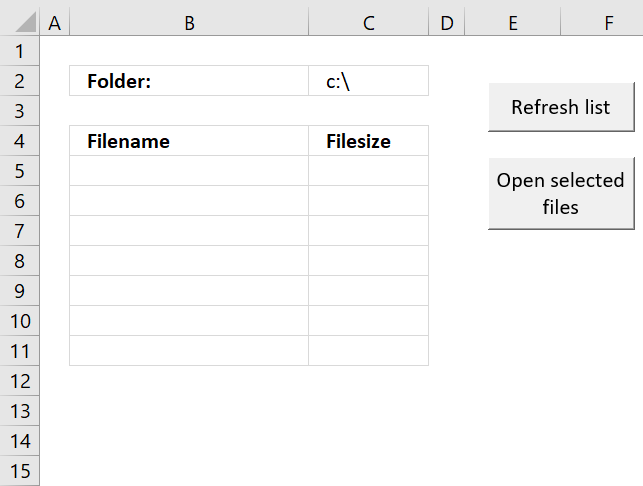
Open Excel files in a folder [VBA]
This tutorial shows you how to list excel files in a specific folder and create adjacent checkboxes, using VBA. The […]
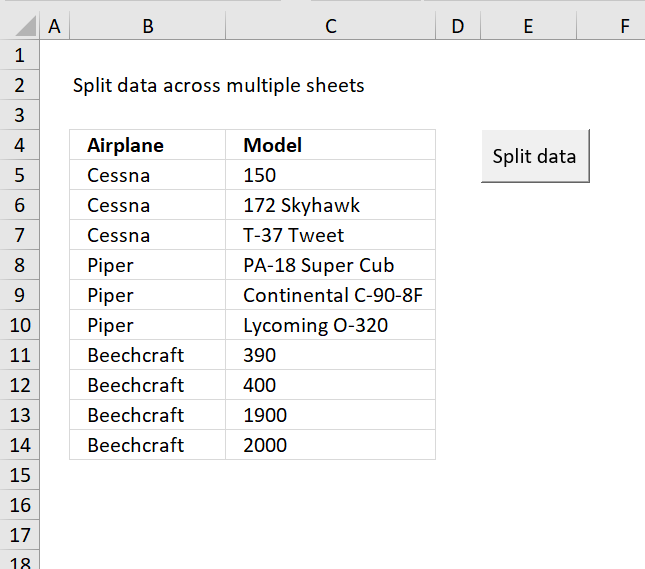
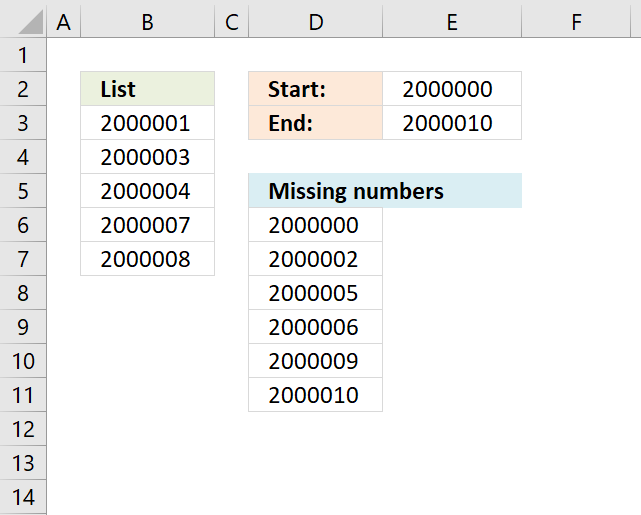
Identify missing numbers in a column
The image above shows an array formula in cell D6 that extracts missing numbers i cell range B3:B7, the lower […]

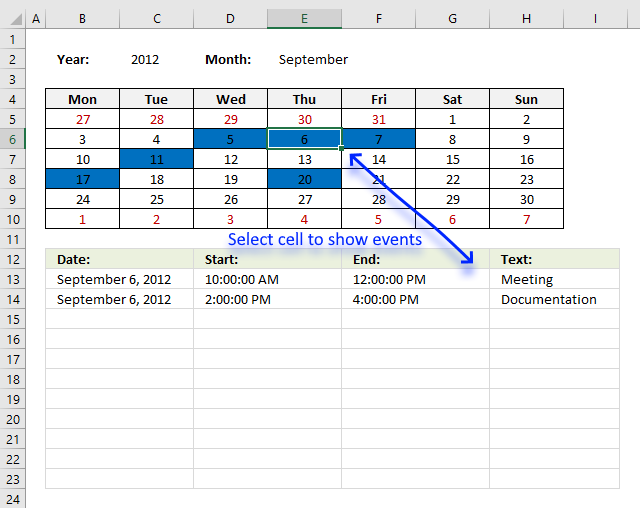
Excel calendar [VBA]
This workbook contains two worksheets, one worksheet shows a calendar and the other worksheet is used to store events. The […]
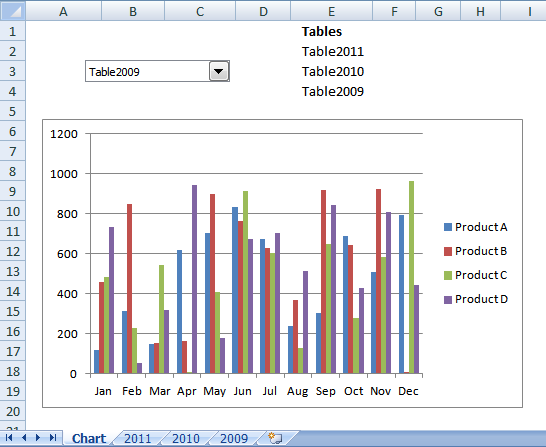
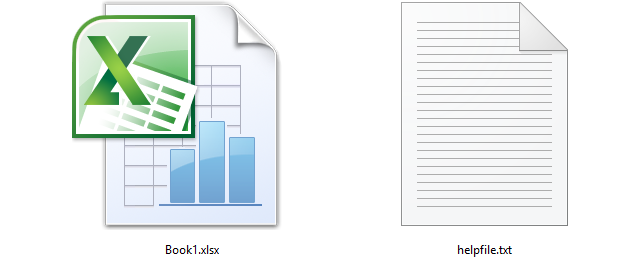
Working with FILES
In this blog article, I will demonstrate basic file copying techniques using VBA (Visual Basic for Applications). I will also […]
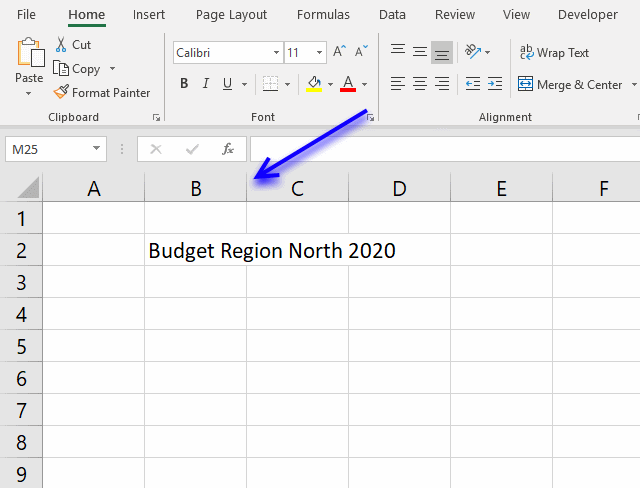
Auto resize columns as you type
Excel does not resize columns as you type by default as the image above demonstrates. You can easily resize all […]
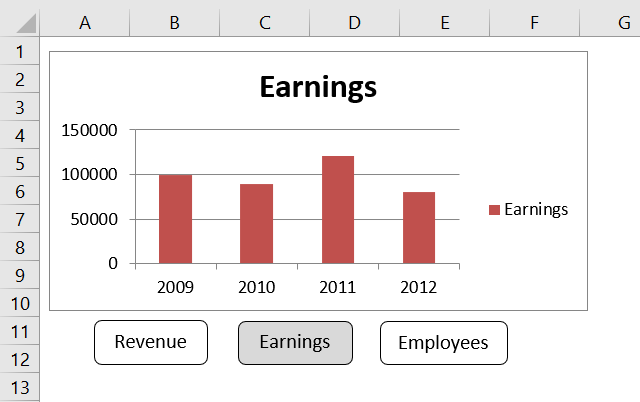
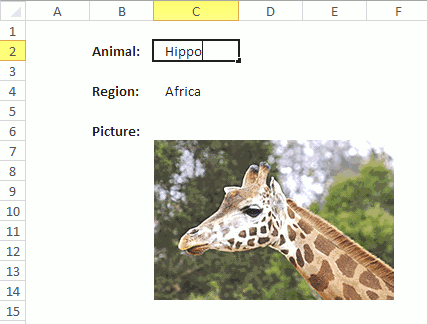
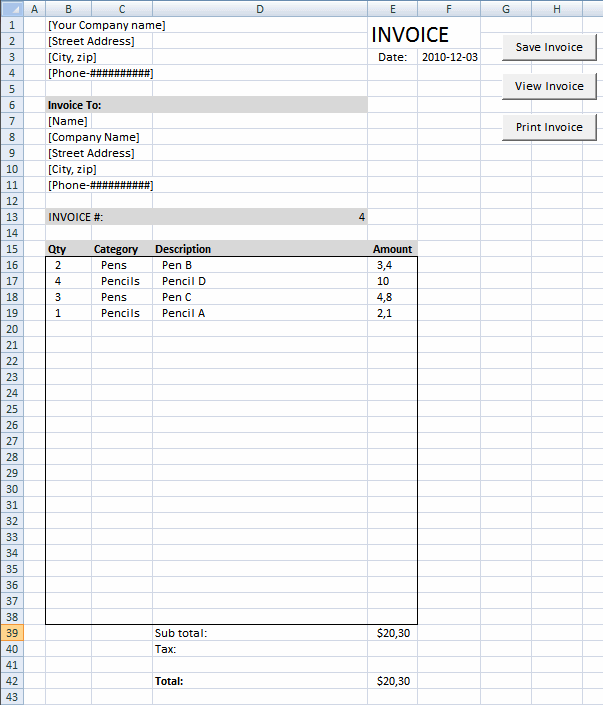
Create a Print button [VBA]
This article describes how to create a button and place it on an Excel worksheet then assign a macro to […]
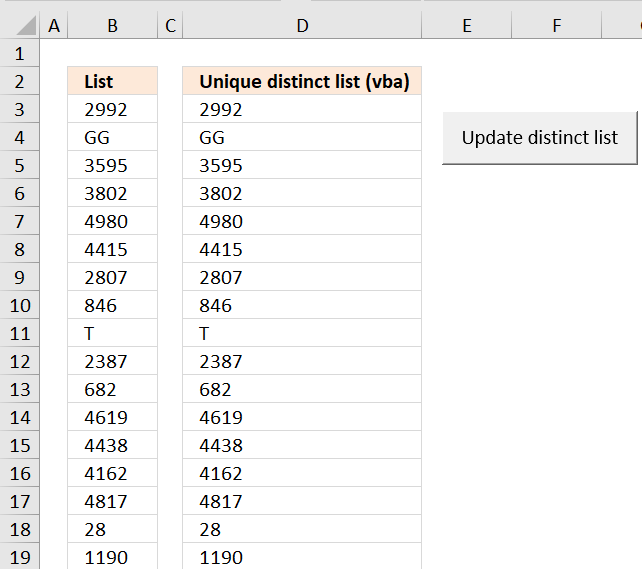
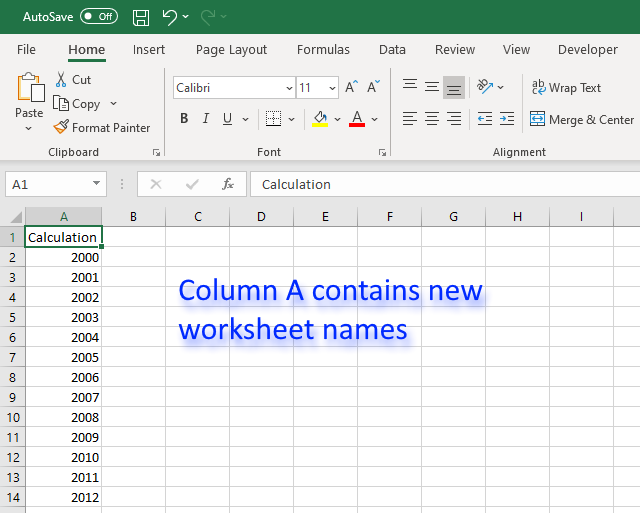
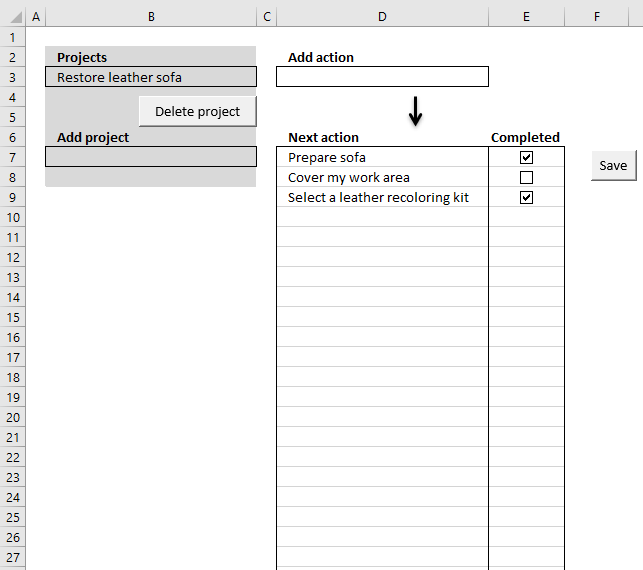
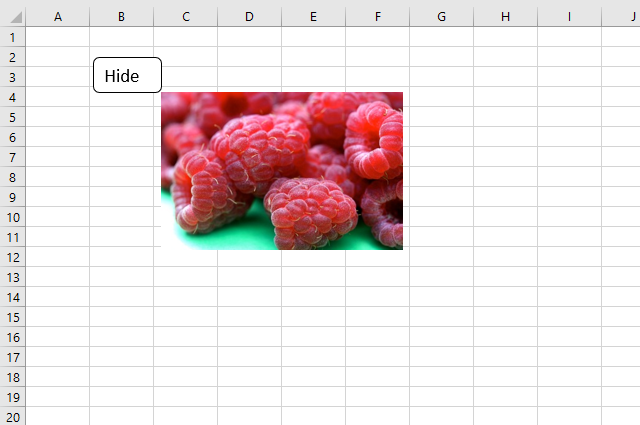
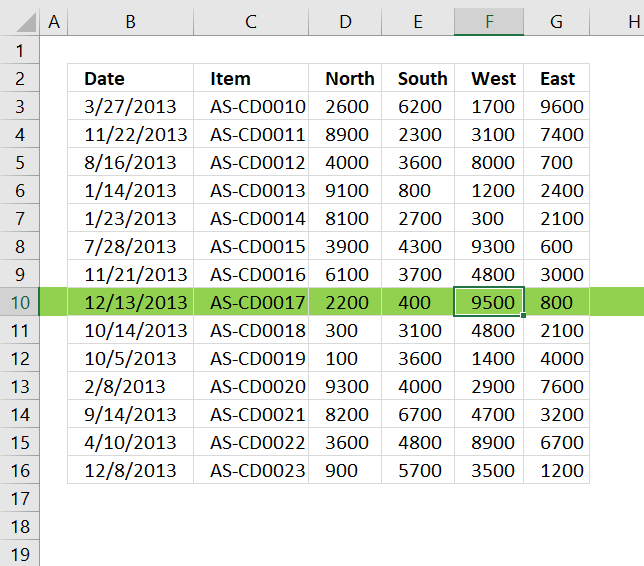
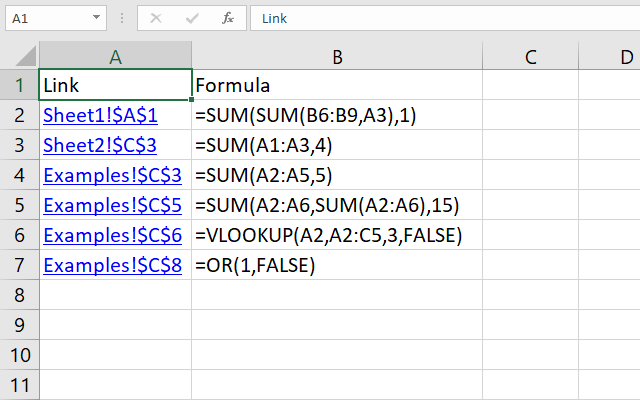
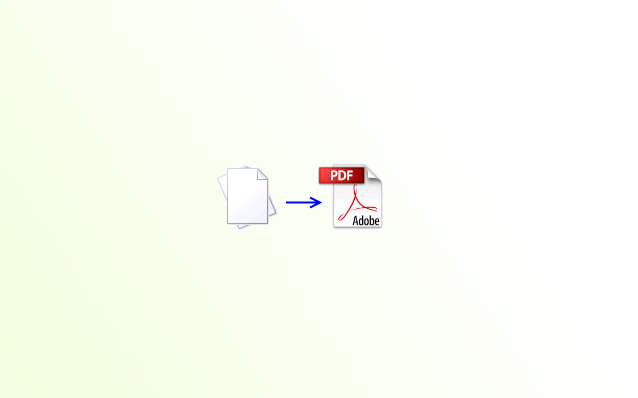
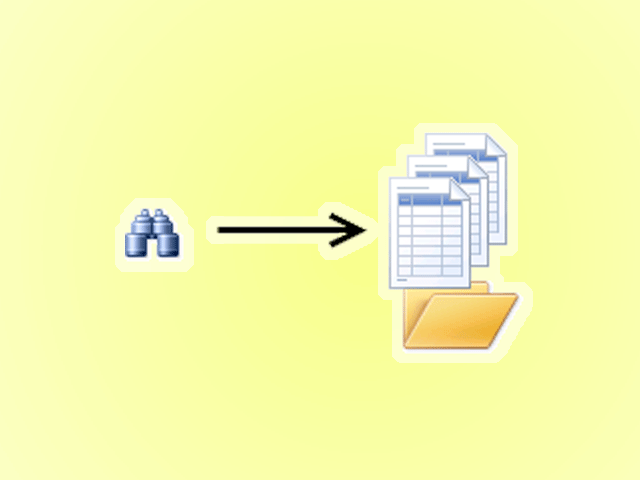
Search all workbooks in a folder
Today I’ll show you how to search all Excel workbooks with file extensions xls, xlsx and xlsm in a given folder for a […]

Save invoice data [VBA]
This article demonstrates a macro that copies values between sheets. I am using the invoice template workbook. This macro copies […]
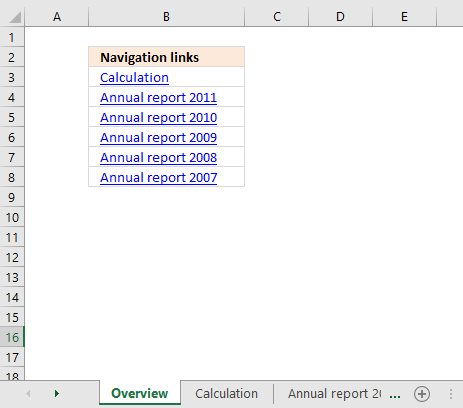
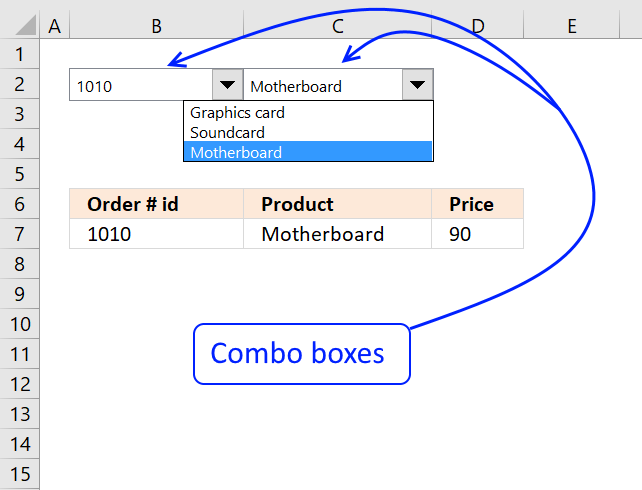

Open Excel files in a folder [VBA]
This tutorial shows you how to list excel files in a specific folder and create adjacent checkboxes, using VBA. The […]
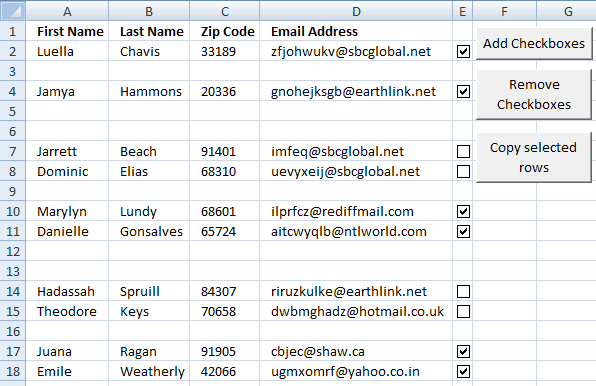
Copy selected rows (checkboxes) (2/2)
This article demonstrates a macro that copies selected rows based on enabled check boxes. The image above shows data on […]



Identify missing numbers in a column
The image above shows an array formula in cell D6 that extracts missing numbers i cell range B3:B7, the lower […]

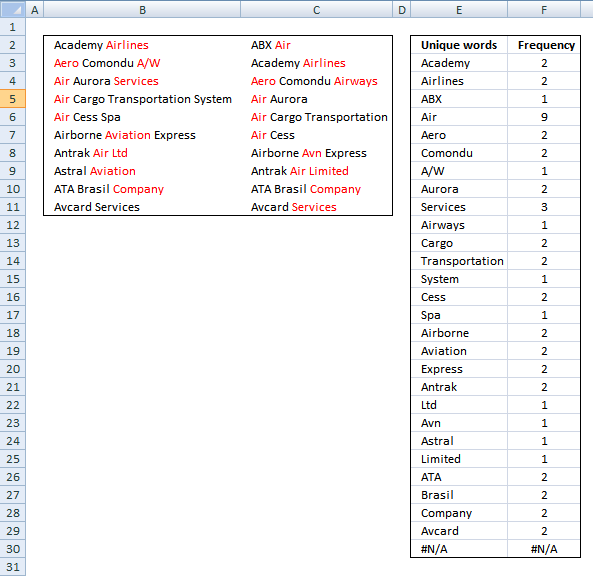
Analyze word frequency in a cell range
This article demonstrates two ways to calculate the number of times each word appears in a given range of cells. […]

Excel calendar [VBA]
This workbook contains two worksheets, one worksheet shows a calendar and the other worksheet is used to store events. The […]


Working with FILES
In this blog article, I will demonstrate basic file copying techniques using VBA (Visual Basic for Applications). I will also […]
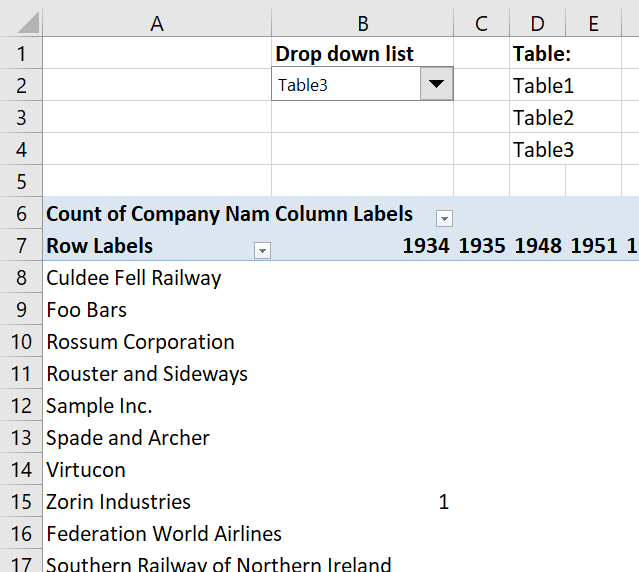

Auto resize columns as you type
Excel does not resize columns as you type by default as the image above demonstrates. You can easily resize all […]

Create a Print button [VBA]
This article describes how to create a button and place it on an Excel worksheet then assign a macro to […]


Latest updated articles.
More than 300 Excel functions with detailed information including syntax, arguments, return values, and examples for most of the functions used in Excel formulas.
More than 1300 formulas organized in subcategories.
Excel Tables simplifies your work with data, adding or removing data, filtering, totals, sorting, enhance readability using cell formatting, cell references, formulas, and more.
Allows you to filter data based on selected value , a given text, or other criteria. It also lets you filter existing data or move filtered values to a new location.
Lets you control what a user can type into a cell. It allows you to specifiy conditions and show a custom message if entered data is not valid.
Lets the user work more efficiently by showing a list that the user can select a value from. This lets you control what is shown in the list and is faster than typing into a cell.
Lets you name one or more cells, this makes it easier to find cells using the Name box, read and understand formulas containing names instead of cell references.
The Excel Solver is a free add-in that uses objective cells, constraints based on formulas on a worksheet to perform what-if analysis and other decision problems like permutations and combinations.
An Excel feature that lets you visualize data in a graph.
Format cells or cell values based a condition or criteria, there a multiple built-in Conditional Formatting tools you can use or use a custom-made conditional formatting formula.
Lets you quickly summarize vast amounts of data in a very user-friendly way. This powerful Excel feature lets you then analyze, organize and categorize important data efficiently.
VBA stands for Visual Basic for Applications and is a computer programming language developed by Microsoft, it allows you to automate time-consuming tasks and create custom functions.
A program or subroutine built in VBA that anyone can create. Use the macro-recorder to quickly create your own VBA macros.
UDF stands for User Defined Functions and is custom built functions anyone can create.
A list of all published articles.
Add values to a ComboBox in a UserForm in Excel.
There are 3 simple ways to add values, two that require VBA, and one that doesn’t require any programming at all.
(If you read the tutorial on how to add values to a ListBox, it is exactly the same as this tutorial and the same methods are used.)
Sections:
Where to Add Items for the ComboBox
Add Values to ComboBox — Method 1
Add Values to ComboBox — Method 2
Add Values to ComboBox — Method 3
Notes
Where to Add Items for the ComboBox
To add items to a ComboBox using Method 2 and Method 3 below, we have to use some VBA code and this code must go within the UserForm. Skip this section if you want to store the list in a worksheet in Excel and use Method 1.
Go to the VBA window (Alt + F11) and make sure you are viewing the Project window (Ctrl + R).
Right-click over the desired UserForm and click View Code.
In the window that opens, select UserForm from the left drop-down menu and Initialize from the right drop-down menu.
Once you do this, you will see the code section UserForm_Initialize() like in the above image.
This is where the code goes, inbetween the two lines of code above.
The reason the code goes here is because this is the code that will run when the UserForm starts-up or opens and we want the ComboBox to be filled with the desired values immediately when the form opens.
If you already have the UserForm_Initialize section with code in it, just add the code for the ComboBox in the existing section.
Add Values to ComboBox — Method 1
Simple and requires no coding.
We create this list from a range of values in Excel. There is no coding required, so we don’t need to use any VBA or go to the Code window like in the last section.
Go to the VBA window (Alt + F11) > double-click the UserForm from the Project window (Ctrl + R if it’s not visible) and then, once the form is visible, click the ComboBox that you want to fill with values.
Look to the Properties window and scroll down to RowSource. If the Property window isn’t visible, hit F4.
In there, enter the sheet and range reference to the list of data.
It is a good idea to include the sheet reference infront of the range, otherwise the ComboBox will assume the range is from the worksheet that you were on when you launched the UserForm.
In my example, the list is on sheet 1 in range G5 to G8: Sheet1!G5:G8
This is a very easy way to make and maintain a list for a ComboBox in Excel.
Tip: if you don’t want the user to be able to see or change this list, put it on a hidden worksheet.
Add Values to ComboBox — Method 2
Simple. Good for small lists. Requires VBA code — first section above explains where to put this code.
With ComboBox1
.AddItem "Item 1"
.AddItem "Item 2"
.AddItem "Item 3"
.AddItem "Item 4"
End WithComboBox1 is the name of the ComboBox that we want to populate with data. The name of the ComboBox is found in the Properties window at the top and is called (Name).
.AddItem is what adds the value to the ComboBox.
Whatever you put inbetween the quotation marks after AddItem is what will be added to the list.
This method is cumbersome if you have a large list, but it is probably the most intuitive and easiest to understand.
Add Values to ComboBox — Method 3
More advanced, but not too difficult. Better for larger lists of items. Requires VBA code — first section above explains where to put this.
ComboBox1.List = Array("Item 1", "Item 2", "Item 3", "Item 4")ComboBox1 is the name of the ComboBox that we will fill with values. The name of the ComboBox is found in the Properties window at the top and is called (Name).
.List adds the items from the array.
Array is the function that is used to create an array of the items for the list. If this seems confusing, don’t worry about it, just follow the syntax from the example above.
Note on Array Creation
This example uses an array to fill the list. There are many ways to create an array and some work better than others for long lists.
Here is an example that works like the last one, just with a little extra code so that we can build the array in a more visually intuitive manner, hopefully.
'Put values into an array
myArray = Split("Item 1;Item 2;Item 3;Item 4", ";")
'Add the array to the ComboBox
ComboBox1.List = myArrayWe use the Split function to turn the values in the parenthesis into an array and we use a semi-colon to separate each item in the list.
The highlight of this version is that you don’t have to put quotation marks around every single item.
Notes
As you can see, there are a number of ways to add a list to a ComboBox. Choose whichever method works best for you!
Make sure to download the sample file for this tutorial to see these examples in Excel — note that the examples with code have been commented-out, simply remove the comment (single quotation mark) from the lines with the code to test out those methods.
Similar Content on TeachExcel
Add Values to a ListBox
Tutorial: How to fill a Listbox with values in a UserForm.
By default, a Listbox in a form will be e…
Dependent ComboBox Drop Down Menus
Tutorial: How to create UserForm drop-down menus that change based on what was selected in another d…
Put Data into a UserForm
Tutorial: How to take data from Excel and put it into a UserForm. This is useful when you use a form…
Add Text to UserForms and Labels
Tutorial: Multiple methods for adding text to a UserForm via a Label.
This includes a simple way to …
Multi-Column ComboBox Drop Down Menus in Forms
Tutorial: Multiple columns of data within a UserForm ComboBox drop-down menu in Excel.
I’ll show you…
Pass Values from One Macro to Another Macro
Tutorial:
How to pass variables and values to macros. This allows you to get a result from one macr…


